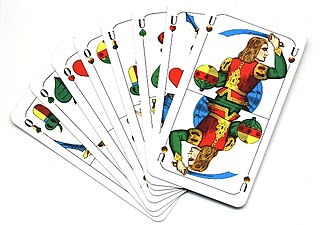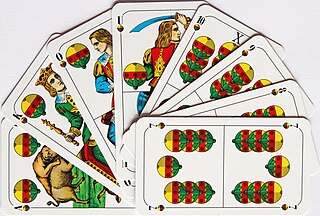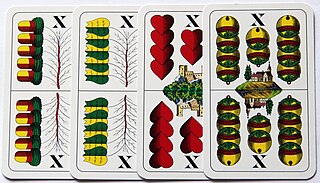
Schafkopf, also called Bavarian Schafkopf, is a popular German trick-taking card game of the ace–ten family for four players that evolved, towards the end of the 19th century, from German Schafkopf. It is still very popular in Bavaria, where it is their national card game played by around two million people, but it also played elsewhere in Germany and in Austria. It is an official cultural asset and important part of the Old Bavarian and Franconian way of life. Schafkopf is a mentally demanding pastime that is considered "the supreme discipline of Bavarian card games" and "the mother of all trump games."

Doppelkopf, sometimes abbreviated to Doko, is a trick-taking card game for four players.

German Solo or just Solo is a German 8-card plain-trick game for 4 individual players using a 32-card, German- or French-suited Skat pack. It is essentially a simplification of Quadrille, itself a 4-player adaptation of Ombre. As in Quadrille, players bid for the privilege of declaring trumps and deciding whether to play alone or with a partner. Along with Ombre, Tarock and Schafkopf, German Solo influenced the development of Skat. Parlett calls it a "neat little descendant of Quadrille" and "a pleasant introduction" to the Ombre family of games.

Bieten, Laubbieten, Lab bietn or Labbieten or Bavarian Poker is a card game that is popular in the Austrian Tyrol and the Bavarian Prealps. It used to be a game frequently played by timber rafters and muleteers. It can be seen as a precursor to the traditional Tyrolean game of Perlaggen. The unusual feature of Bieten is the nature of the competition. The players have the option, even if they have a poor hand, of persuading their opponent(s) to cave in through skilful bidding (Bieten) and bluffing.

Bavarian Tarock or, often, just Tarock, is a card game that was once popular in Bavaria and also played in parts of Austria as well as Berlin. The name is a clue to its origin in the historical German game of [Gross-]Tarock, a game using traditional Tarot cards. At some point in the mid- to late-18th century, attempts were made to emulate Taroc using a standard 36-card German-suited pack, resulting in the formerly popular, south German game of German Tarok. During the last century, the variant played with a pot (Haferl) and often known as Bavarian Tarock or Haferltarock, evolved into "quite a fine game" that, however, has less in common with its Tarock progenitor. German Tarok also generated the very similar game of Tapp, played in Württemberg, and both are related to Bauerntarock, Dobbm and the American games of Frog and Six-Bid Solo. Bavarian Tarock should not be confused with Königrufen, also known as Austrian Tarock or just Tarock.

Tapp is a trick-taking, card game for 3 or 4 players using 36 French-suited cards that is played in the south German region of Swabia, especially in the former Kingdom of Württemberg. It is the French-suited offshoot of German Tarok; its German-suited form being called Württemberg Tarock in that region. Tapp is one of a family of similar games that include Bavarian Tarock, the Austrian games of Bauerntarock and Dobbm, and the American games of Frog and Six-Bid Solo. Although probably first played in the early nineteenth century, the game of Tapp is still a local pastime in its native Württemberg, albeit in a greatly elaborated form.

Wendish Schafkopf, Wendisch or Wendsch is an old German card game for four players that is still played today. It uses a Schafkopf pack of German-suited cards or a Skat pack of French playing cards.

Bohemian Watten, sometimes called Bohemian Ramsen, is a trick-taking card game for two to four players. In fact, Bohemian Watten bears more resemblance to Zwanzig ab, Ramsen and Schnalzen than Watten itself.

Brandeln is an historical card game for three or four players; in which the winning bidder plays alone against the rest. It is one of the earliest games to use the terms Bettel – a contract to lose every trick – and Mord - a contract to win every trick. One of several card games mastered by Mozart, Brandeln is still current in Austria and Germany today. It has been described as having a "civilized, refined and ingenious character" and "one of the most pleasant card games".

Grasobern, Grasoberl, Grasoberln, Graseberla, Grünobern, Lauboberl or Laubobern is a card game that was once commonly played in Old Bavaria, especially in the old counties of Bad Aibling and Rosenheim, and is still popular in eastern Bavaria, especially in Upper Palatinate. The game has relatively simple rules and thus a rather relaxing and leisurely character without the mental demands of Schafkopf or psychological stress of Watten, two other traditional Bavarian card games. The name is taken from the game's penalty card, the Ober of Leaves. The suit of Leaves is known in German variously as Laub, Gras ("grass") or Grün ("green").

Bolachen is a traditional card game for 3 players that is played in parts of southern Upper Bavaria, especially in the Rupertiwinkel area of the Berchtesgaden Land, where there is a cultural influence from Salzburg, and the state of Salzburg itself. It is a Bavarian variant of the more complex, old Austrian game of Préférence. Like its Bavarian cousin, Wallachen, Bolachen is threatened by extinction.

Blattla is a Bavarian card game for four players, who usually form two teams of two for each deal. It is a simplified version of Schafkopf and Bierkopf and is thus a point-trick game. Unlike those two games, in Blattla the Obers and Unters are not permanent trumps. In order to learn the rules of Schafkopf, it can be an advantage to first become familiar with Blattla. The game is traditionally played with Bavarian pattern cards.

Herzla or Herzl'n is a Bavarian, reverse trick-taking, card game for 4 players in which the aim is to avoid taking any Hearts. There is a simpler variant for children and adults that may be played by 3-8 players.
Lampeln or Lampln is an old Bavarian and Austrian plain-trick card game that is still played in a few places today. It is one of the Rams group of card games characterised by allowing players to drop out of the current game if they think they will be unable to win any tricks or a minimum number of tricks.

Ramsen or Ramsch is a traditional Bavarian plain-trick, card game for three to five players that is played with a 32-card German-suited pack and is suitable both for adults and for children. It is one of the Rams group of card games that are distinguished by allowing players to drop out if they think they will fail to win the required number of tricks. An unusual feature of Ramsen is the presence of four permanent trump cards that rank just below the Trump Sow (Ace). It should not be confused with the contract of Ramsch in games like Skat or Schafkopf, nor with the related game of Rams which is also called Ramsenin Austria, but is played with a Piquet pack, does not have permanent trumps and has a different card ranking.

Matzlfangen is a traditional point-trick, card game for 4 players that originated in the Bavarian province of Upper Palatinate over 200 years ago and spread to Austria. It is still played in a few places today. The game is named after the Ten or Matzl, which plays a key role.

Officers' Schafkopf is a German point-trick, card game for two players which is based on the rules of Schafkopf. The game is a good way to learn the trumps and suits for normal Schafkopf and to understand what cards one is allowed to play. It is similar in concept to Officers' Skat.
Herzblatt or Herzblättchen is a German card game of the ace–ten family for two to five players. It bears a certain resemblance to the extinct 19th-century game of Piquesept, however without the special rules associated with the trump Seven.

German Tarok, sometimes known as Sansprendre or simply Tarok, is an historical ace–ten card game for three players that emerged in the 18th century and is the progenitor of a family of games still played today in Europe and North America. It became very popular in Bavaria and Swabia during the 19th century before being largely superseded by Schafkopf, but has survived in the local forms of Bavarian Tarock and Tapp. During the mid-19th century, it became the most popular card game among Munich's middle classes and was also played in the late 19th and early 20th centuries by notable Bavarian author Ludwig Thoma, frequently appearing in his novels and journal articles. It was superseded after the First World War by other forms such as Bavarian Tarock.
Schlauch is an extinct Bavarian point-trick card game that was popular in the mid-19th century as a drinking game, hence it was also known as Bier-Schlauch.















